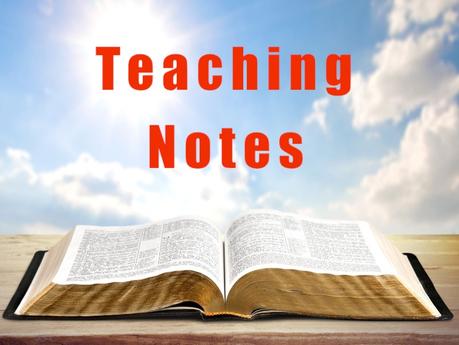Grace Thoughts
Teaching Notes: On Genesis 10

Teaching Notes are Bible studies we taught before GraceLife Ministries began publishing articles online in 1995. Some were presented as sermons, others as group studies.
Our hope is that these older studies will be a blessing to you in your life and ministry. Please use them in any way God leads you.
These teaching notes are from a series of studies about the Book of Genesis.
[These notes are from a study from almost 45 years ago.]
Genesis 10:1-32
“Now these are the generations of the sons of Noah, Shem, Ham, and Japheth: and unto them were sons born after the flood. The sons of Japheth; Gomer, and Magog, and Madai, and Javan, and Tubal, and Meshech, and Tiras. And the sons of Gomer; Ashkenaz, and Riphath, and Togarmah. And the sons of Javan; Elishah, and Tarshish, Kittim, and Dodanim. By these were the isles of the Gentiles divided in their lands; every one after his tongue, after their families, in their nations. And the sons of Ham; Cush, and Mizraim, and Phut, and Canaan. And the sons of Cush; Seba, and Havilah, and Sabtah, and Raamah, and Sabtechah: and the sons of Raamah; Sheba, and Dedan. And Cush begat Nimrod: he began to be a mighty one in the earth. He was a mighty hunter before the Lord: wherefore it is said, Even as Nimrod the mighty hunter before the Lord. And the beginning of his kingdom was Babel, and Erech, and Accad, and Calneh, in the land of Shinar. Out of that land went forth Asshur, and builded Nineveh, and the city Rehoboth, and Calah, And Resen between Nineveh and Calah: the same is a great city. And Mizraim begat Ludim, and Anamim, and Lehabim, and Naphtuhim, And Pathrusim, and Casluhim, (out of whom came Philistim,) and Caphtorim. And Canaan begat Sidon his first born, and Heth, And the Jebusite, and the Amorite, and the Girgasite, And the Hivite, and the Arkite, and the Sinite, And the Arvadite, and the Zemarite, and the Hamathite: and afterward were the families of the Canaanites spread abroad. And the border of the Canaanites was from Sidon, as thou comest to Gerar, unto Gaza; as thou goest, unto Sodom, and Gomorrah, and Admah, and Zeboim, even unto Lasha. These are the sons of Ham, after their families, after their tongues, in their countries, and in their nations. Unto Shem also, the father of all the children of Eber, the brother of Japheth the elder, even to him were children born. The children of Shem; Elam, and Asshur, and Arphaxad, and Lud, and Aram. And the children of Aram; Uz, and Hul, and Gether, and Mash. And Arphaxad begat Salah; and Salah begat Eber. And unto Eber were born two sons: the name of one was Peleg; for in his days was the earth divided; and his brother’s name was Joktan. And Joktan begat Almodad, and Sheleph, and Hazarmaveth, and Jerah, And Hadoram, and Uzal, and Diklah, And Obal, and Abimael, and Sheba, And Ophir, and Havilah, and Jobab: all these were the sons of Joktan. And their dwelling was from Mesha, as thou goest unto Sephar a mount of the east. These are the sons of Shem, after their families, after their tongues, in their lands, after their nations. These are the families of the sons of Noah, after their generations, in their nations: and by these were the nations divided in the earth after the flood.”
We are now embarking on the genealogy of the people who repopulated the earth. This is important because we will see these people (nations) surfacing again in the future of God’s people. Not all of the geneologies of each son is given — only the ones God wanted us to know about.
The first list mentioned is the line of Japheth. Seven sons are listed: Gomer, Magog, Madai, Javan, Tubal, Meshech and Tiras.
Gomer (gōmer), Magog (māḡōḡ), Madai (māḏay), Javan (yāwān), Tubal (ṯuḇāl), Meshech (mešeḵ), and Tiras (ṯîrās) fathered the nations of the north and northeast (Europe & Asia). From those lines come the people who populated the west (North and South America).
Two of the sons are chosen to show their sons (grandchildren of Japheth) — Gomer and Javan. Gomer’s descendants populated what is now Southern Russia and captured Cappadocia and some parts of Asia Minor. Javan’s descendants went into the areas of Greece, Rome, France, Spain, Portugal, Italy, etc.
The three sons of Gomer mentioned are Ashkenaz, Riphath and Togarmah.
Ashkenaz (’aškănaz) probably located near Armenia; Riphath (rîp̄aṯ) were probably the Paphlagonians; and Togarmah (ṯōḡarmāh) probably located in southeastern Armenia.
Four sons of Javan are mentioned: Elisah, Tarshish, Kittim and Dodanim.
Elisah (’ĕlîšāh), “God saves,” settled in southern Italy; Tarshish (ṯaršîš) settled in the areas of Portugal and Spain; Kittim (kittîm) seems to be Cyprus; and Dodanim (ḏōḏānîm) probably went to the island of Rhodes.
As is mentioned in the parenthesis, these were maritime peoples. They are all close to water.
Different languages (lilšōnō) are mentioned here for the first time.
Ham had four sons mentioned in verse 6: Cush (kūš), Mizraim (miṣrayim), Put (p̄ūṭ), and Canaan (ḵənā‘an).
In verse 7 we’re introduced to the sons of Cush: Seba (səḇā), Havilah (ḥăwîlāh), Sabtah (saḇhtā or saḇhtāh), Raamah (ra‘māh), and Sabtechah (saḇtəḵā).
Verse 7 goes on to give us the names of Raamah’s sons: Sheba (šəḇā) and Dedan (ḏəḏān).
The descendants of Ham seem to have moved south into Africa and part of Arabia. Canaan was the Holy Land that Israel took from them at a later date.
Verse 8 introduces us to another son of Cush — Nimrod (nimrōḏ). He was a hunter of wild beasts and as such was probably a hero to the people of his day. He became a great leader (had a kingdom) and centered his empire in Babylon, Erech, Akkad and Calneh in Shinar.
Shinar (šin-‘ār) is probably the whole area called the kingdom of Babylon. More will be said about Shinar in the next chapter.
From this place Nimrod moved out to Assyria and built Ninevah, Rehoboth Ir, Calah and Resen.
He may have been the first to use a writing form (cuneiform script).
Nimrod had phenomenal power over the land.
The Hamatic line is, I believe, the “flesh line” of Scripture always in opposition to the godly or “spiritual line.”
Verse 13 introduces Mizraim as father to several clans. Mizraim means “Egypt.” Here is a listing of those clans:
- Ludites
- Anamites
- Lehabites
- Naphtuhites
- Pathrusites
- Casluhites (Philistines came from them)
- Caphtorites
Canaan fathered the following clans:
- Sidonians
- Hittites
- Jebusites
- Amorites
- Girgashites
- Hivites
- Arkites
- Sinites
- Arvadites
- Zemarites
- Hamathites
The Canaanite clans scattered at a later time. The borders of Canaan reached from Sidon toward Gerar as far as Gaza, and then toward Sodom, Gomorrah, Admah and Zeboiim, as far as Lasha.
Next, in verse 21, the biblical account takes us into the line of Shem: Elam (‘ê-lām), Asshur (’aš-šūr), Arphaxad (arpaḵšaḏ), Lud (lūḏ), and Aram (’ă-rām).
The sons of Aram were Uz (‘ūṣ), Hul (ḥūl), Gether (ḡeṯer), and Mash (maš).
The sons of Arphaxad listed include only Shelah (šālaḥ). However, as we learn later, he is the line of the Messiah from Shem.
Shelah’s son is Eber (‘êḇer).
Eber had two sons: Peleg (pe-leḡ), which means “division” and Joktan (yāqəṭān).
Peleg received his name because the earth was divided in his time. This probably speaks to the scattering of the nations and confounding of speech. He may have received it prophetically in advance or after the fact.
Joktan was the split off from the Messianic line, which went through his brother Peleg. Joktan was the father of 13 sons: Almodad, Sheleph, Hazarmaveth, Jerah, Hadoram, Uzal, Diklah, Obal, Abimael, Sheba, Ophir, Havilah, and Jobab.
They lived in the region that stretched from Mesha toward Sephar, in the eastern hill country
The territories of Shem’s descendants took up the middle part of the old world.
Next Time
We will look at Genesis Chapter 11 in the next part of our special series.
[Thank you for reading these teaching notes from almost 45 years ago. My prayer is they will be a blessing to you and your life and ministry.]
 ShemHamJaphethTeaching NotesGenesisNations
ShemHamJaphethTeaching NotesGenesisNations

Published by gracelifethoughts
Founder & Director of GraceLife Ministries View all posts by gracelifethoughts
